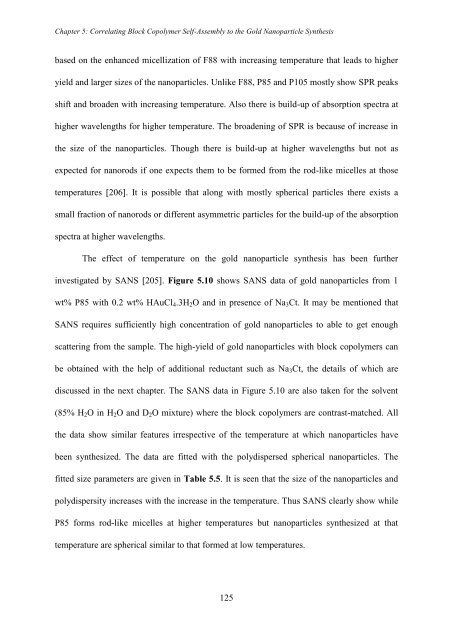PHYS01200704032 Debes Ray - Homi Bhabha National Institute
PHYS01200704032 Debes Ray - Homi Bhabha National Institute
PHYS01200704032 Debes Ray - Homi Bhabha National Institute
You also want an ePaper? Increase the reach of your titles
YUMPU automatically turns print PDFs into web optimized ePapers that Google loves.
Chapter 5: Correlating Block Copolymer Self-Assembly to the Gold Nanoparticle Synthesis<br />
based on the enhanced micellization of F88 with increasing temperature that leads to higher<br />
yield and larger sizes of the nanoparticles. Unlike F88, P85 and P105 mostly show SPR peaks<br />
shift and broaden with increasing temperature. Also there is build-up of absorption spectra at<br />
higher wavelengths for higher temperature. The broadening of SPR is because of increase in<br />
the size of the nanoparticles. Though there is build-up at higher wavelengths but not as<br />
expected for nanorods if one expects them to be formed from the rod-like micelles at those<br />
temperatures [206]. It is possible that along with mostly spherical particles there exists a<br />
small fraction of nanorods or different asymmetric particles for the build-up of the absorption<br />
spectra at higher wavelengths.<br />
The effect of temperature on the gold nanoparticle synthesis has been further<br />
investigated by SANS [205]. Figure 5.10 shows SANS data of gold nanoparticles from 1<br />
wt% P85 with 0.2 wt% HAuCl 4 .3H 2 O and in presence of Na 3 Ct. It may be mentioned that<br />
SANS requires sufficiently high concentration of gold nanoparticles to able to get enough<br />
scattering from the sample. The high-yield of gold nanoparticles with block copolymers can<br />
be obtained with the help of additional reductant such as Na 3 Ct, the details of which are<br />
discussed in the next chapter. The SANS data in Figure 5.10 are also taken for the solvent<br />
(85% H 2 O in H 2 O and D 2 O mixture) where the block copolymers are contrast-matched. All<br />
the data show similar features irrespective of the temperature at which nanoparticles have<br />
been synthesized. The data are fitted with the polydispersed spherical nanoparticles. The<br />
fitted size parameters are given in Table 5.5. It is seen that the size of the nanoparticles and<br />
polydispersity increases with the increase in the temperature. Thus SANS clearly show while<br />
P85 forms rod-like micelles at higher temperatures but nanoparticles synthesized at that<br />
temperature are spherical similar to that formed at low temperatures.<br />
125

















